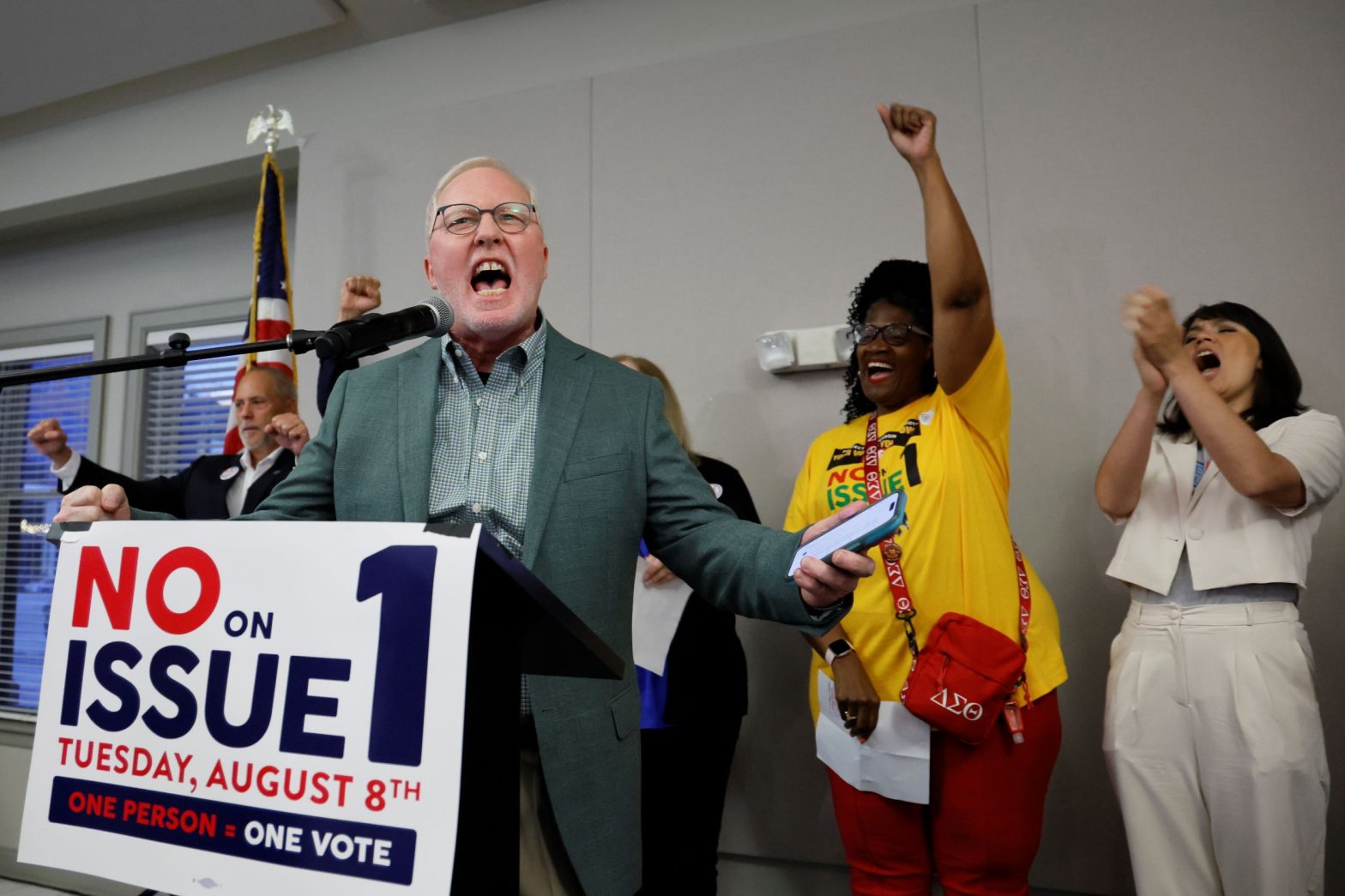Ohio Voters Reject Legislature’s Effort to Stymie Abortion Rights Vote

COLUMBUS, Ohio — Ohio voters rejected an attempt by the state Legislature on Tuesday to make it harder to amend the state constitution, a vote seen as a clear victory for abortion-rights supporters trying to stop lawmakers from placing severe limits on the procedure.
As of Wednesday morning, with 95% of the vote on the ballot initiative counted, the no votes had garnered 57% (a total of 1,744,094 ballots), while the yes votes stood at 43% (with 1,315,346 ballots).
If it had passed, the ballot measure would have required that amendments to the state constitution gain approval of 60% of voters, a significant change from the current rule that they garner a simple majority of the vote.
It also would have required citizens who wanted to place an amendment on the ballot to collect signatures from at least 5% of voters from the last gubernatorial election in all 88 counties, instead of the current 44.
Finally, it would have eliminated a 10-day cure period that allows citizens to replace any signatures deemed faulty by the secretary of state’s office.
And though the word “abortion” appeared nowhere in the ballot language, it was clear that Tuesday’s vote was largely driven by passions stirred by the U.S. Supreme Court’s ruling in Dobbs v. Jackson Women’s Health Organization last year, which overturned Roe v. Wade and wiped out 50 years of courts maintaining women had a constitutional right to an abortion.
With more than 3 million votes cast, Tuesday’s turnout dramatically outnumbers the 1.66 million ballots counted in the state’s highly contested May 2022 primary elections, which featured races for governor, U.S. Senate and the U.S. House.
In the wake of the Supreme Court ruling, the Ohio Legislature joined several other states with Republican-led legislatures in passing a “heartbeat bill” that barred doctors from performing abortions after cardiac activity was detected — which can be as early as six weeks into a pregnancy.
Though a state court has yet to rule on the constitutionality of the law, its passage led to a successful grass-roots effort to place an abortion rights amendment on the November ballot.
The proposed amendment would establish a “fundamental” right to reproductive freedom with “reasonable limits.”
Raising the threshold for adopting an amendment to 60% of votes would have put the ultimate fate of the proposed amendment in substantial doubt, as recent polls show support for granting a constitutional right to abortion access in the state topping out at about 58%.
In a press release issued shortly after the polls closed, the Fairness Project, one of the organizations that opposed the ballot measure, called the apparent outcome, “a major win for democracy and reproductive rights.”
Later, Kelly Hall, the group’s executive director, said in a statement, “this is an incredibly profound and inspiring day for our democracy.”
“When faced with the choice of whether to allow politicians and special interests to consolidate power and strip voters of their rights, Ohioans fought back,” Hall said. “The defeat of Issue 1 should send a clear message to other extremist officials around the country that democracy will not die; people are ready to defend their rights against blatant attacks like this.”
Also weighing in was former U.S. Attorney General Eric Holder Jr., who said via email that “Ohioans have sent a clear message at the ballot box: they wholly reject attempts to weaken democracy and they want to protect their rights when politicians elected on gerrymandered maps refuse to do so.”
“Make no mistake,” continued Holder, who is now chairman of the National Democratic Redistricting Committee, “the state of democracy in Ohio is far from perfect, and the fight for a truly representative democracy will continue for a long time to come. But today, we celebrate that, thanks to the tenacity of the people, yet another lawless attempt to weaken democracy in Ohio has been defeated.
“It should not be lost on the public that Republicans went out of their way to minimize voter turnout in this election: from scheduling the vote in the heat of August of an off-year to misleading voters with incorrect voting information,” he said. “In the face of these outrageous obstacles, the people remained engaged and focused.
“The result continues a pattern we have seen across the country, from the 2022 midterms to the spring election in Wisconsin and now, the August election in Ohio: When democracy is on the ballot, the people of this nation rise to the occasion and participate in order to protect it. The people used their power — and they prevailed,” Holder said.
Disappointed supporters of Tuesday’s ballot measure blamed outside activists and national abortion-rights groups for their defeat, noting that an estimated $20 million in political spending had poured into Ohio ahead of the vote.
“Out-of-state dark money special interest groups, including a Swiss billionaire, just spent millions of dollars in Ohio to deceive voters into not passing Issue 1,” said Peter Range, chief executive officer of Ohio Right to Life, in a written statement.
Despite the outcome of the vote, Range said the organization’s mission remains unchanged.
“This result will not deter us from continuing to fight the ACLU’s extreme agenda this November, which seeks to allow abortion up until birth and take away parents’ rights to protect their child from being pressured into an abortion or even a sex-change operation,” he said.
Hall said she and her organization are “thrilled” voters will now get to have a “true say” on the question of defending reproductive freedom in November.
“The Fairness Project is ready to stand with Ohioans United for Reproductive Rights and looks forward to an aggressive campaign in the coming months to protect abortion rights through the ballot measure process,” she said.
Dan can be reached at [email protected] and at https://twitter.com/DanMcCue
























